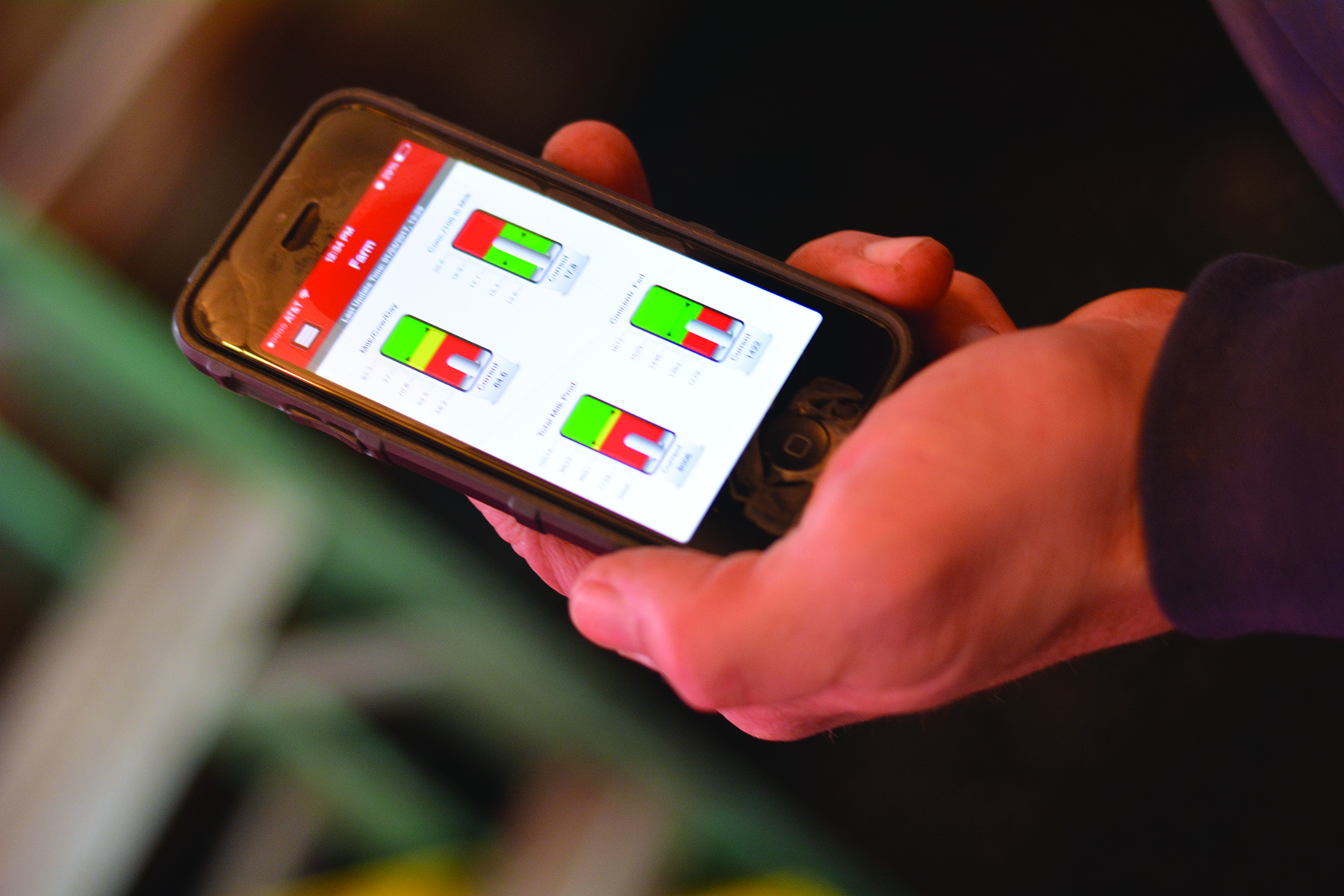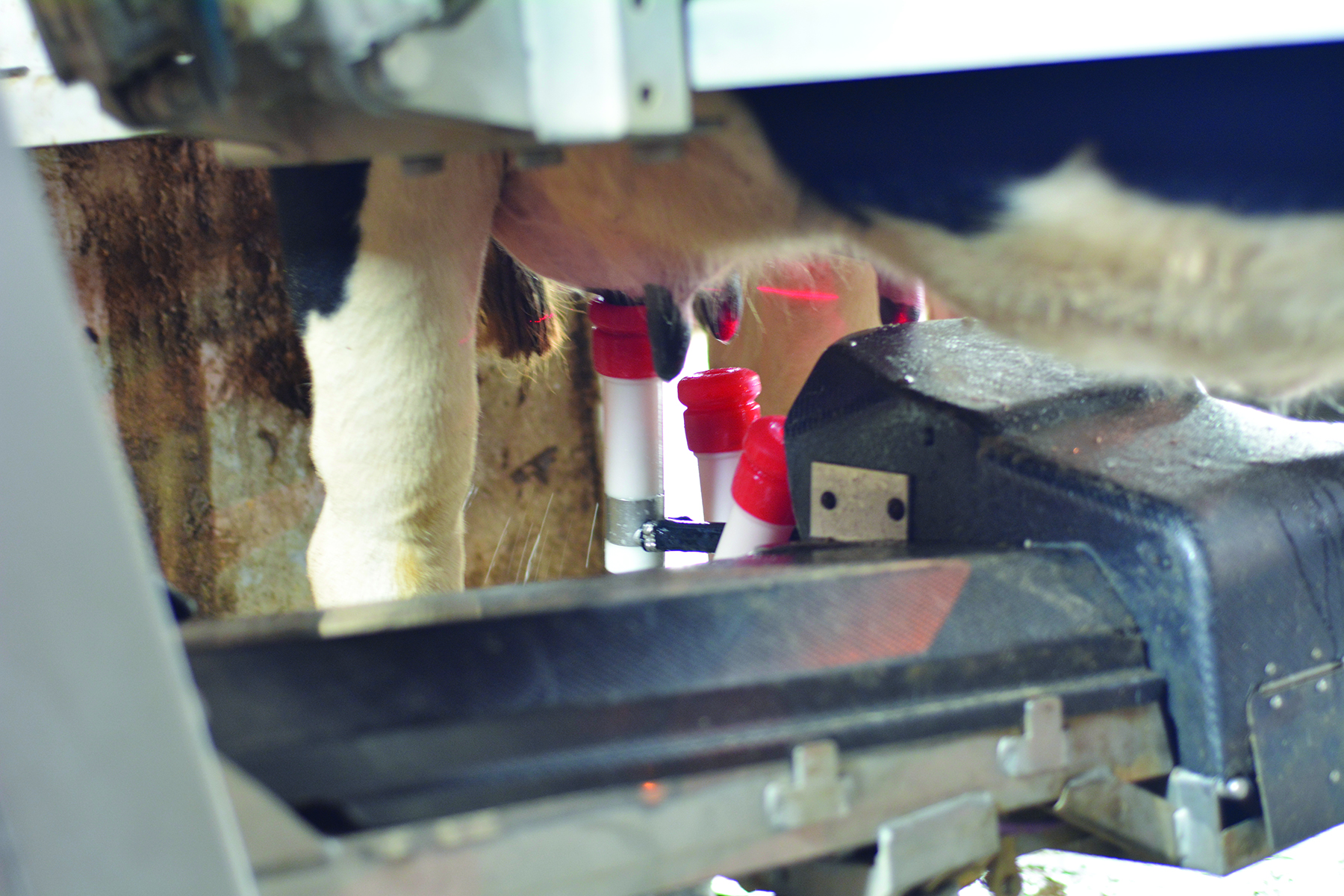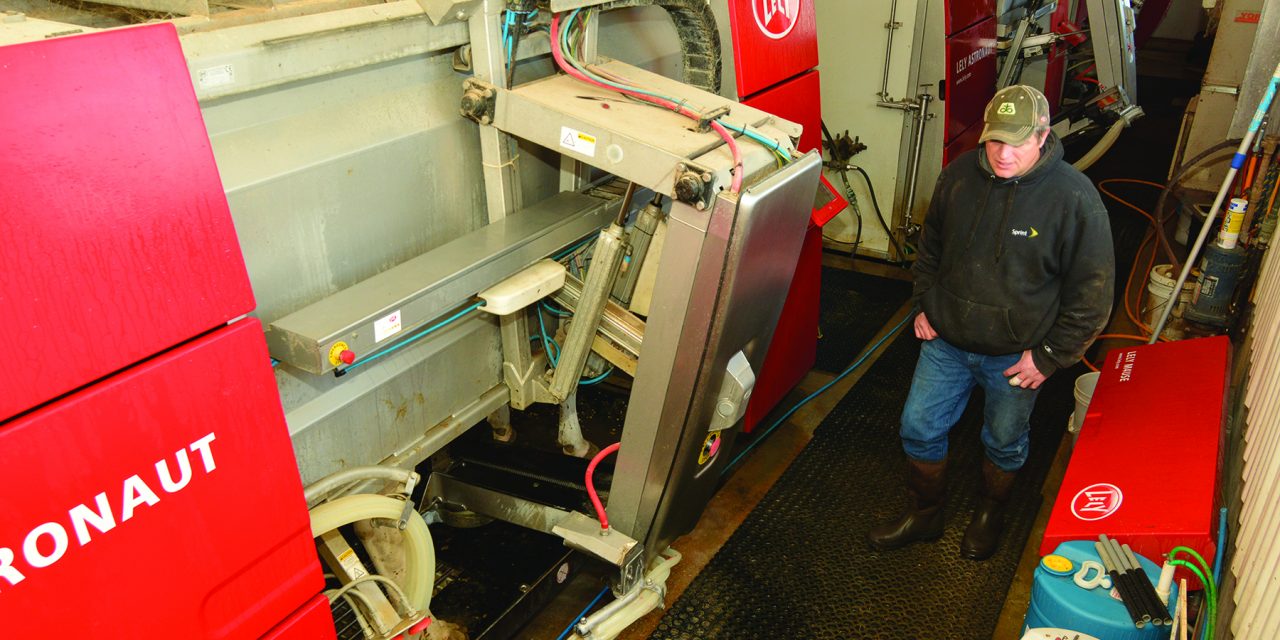Rick Scheer’s dairy looks like any other, until you see the milking barn.

Rick Scheer was tending to some Holstein calves in the barn when he realized something was wrong. The gate behind him didn’t latch close and calves escaped into the pasture. He and his hired hand spent some time rounding the young ones up when a message on his phone said there was a problem in the milking barn. His robots’ day was going about as well. Two of three robots sent him messages that they weren’t working. After the calves were put back in their pen, Rick was in the milking barn with his dad, fixing robots. They got number three up and running along with number one. Robot number two would need a part replaced.
The Scheer Dairy Farm near New Haven has robots that have worked on the farm for the past 5½ years. Their only job is milking cows. When they are working, which is most of the time, Scheer’s 125 dairy cows couldn’t be happier.
In its basic form, the Lely brand Astronaut robotic machines are hi-tech milking stalls. They may not resemble the humanoid-like robots we see in the movies, but they are efficient machines that in combination with a fitness tracker-type cow collar, have improved cow health and milk production.
“They have changed our labor requirements,” Scheer says. “We had a full-time employee that did a lot of the milking for us. He was nearing retirement age. Mom and Dad were nearing retirement age. We looked at the robots as a way of reducing labor requirements.”
It was a big change for a family farm that has milked cows in three different centuries. Scheer’s grandfather bought the land in 1897 and the farm was diversified until it expanded both in acreage and cows to focus on producing milk. Today, Rick and Cindy Scheer are partners with his parents, Gene and Kathy. A full-time employee, Mike, takes care of field work, feeds animals and occasionally helps gather loose calves. High school students help throughout the year.
When the family approached the idea of replacing a milking parlor with robots, Gene was skeptical until they watched a robot do its work on a Illinois farm. “Mom and Dad got excited when they realized it was pretty easy to mechanize that part of the operation,” Scheer says.
Five years ago milking robots were foreign to Missouri dairies, but they were not new. They had been used in Europe for the past 20 years and in the U.S. for the past 10.
The Scheers invested, building a new milking parlor to accommodate three robots. They installed two machines and once they felt comfortable with those, installed a third unit. The family is never going back to conventional milking.
“The robots are like any other tool we use. They are not problem-free or labor-free. Every now and then the robots and I have issues. There are breakdowns and things to fix, but it would be hard to go back to standing in the parlor and milking at 4 a.m. and 4 p.m. every day,” Scheer says.
When a robot is having problems, it will attempt to milk three times before contacting Scheer’s phone. The Lely dealer is just two hours away in southern Illinois and on call 24 hours a day to trouble-shoot issues. That is necessary because these machines milk 24/7 and only take a “coffee break” twice a day to shut down and go through a wash cycle.
Each robot can milk 60 cows daily. The Scheer herd size is normally 160-to-170 dairy cows, but this past winter the herd was smaller, giving the Scheers flexibility to work on the robot with a bad air cylinder that couldn’t move its arm under the cow’s udder.
And, the cows know when the robots are open for business. They go to the machines for milking because lactating cows like to eat. Although they are fed corn silage in the barn, they favor the cracked grain found in a bunk in each milking machine stall. The grain lures the cow to the stall and the robot tailors the amount accessible for each cow to eat. Scheer says the art comes in balancing how much grain is made available in the silage and in the robot bunk.

“The cow walks into the machine and the machine decides if the cow is eligible to be milked. A matrix programmed into the computer says we are going to milk fresh cows more frequently and late lactation cows less frequently. So, we target those cows that can benefit from more frequent milkings,” Scheer says. Some cows are milked four or more times, while others only two times daily.
To watch the connection between machine and animal is like watching dominos fall in an intricate puzzle. Every piece has its place. Sensors are found everywhere and monitor everything. From scales that weigh the cow and feed eaten at each milking, to lasers that measure each teat, the staggering amount of data collected is useful in maintaining animal health and, in turn, milk production. Milk flow from each teat is measured separately. Milking time is compared to the previous milking. Once the cow is in place and is identified to be milked, an arm with rotating brushes swings out to clean the teats. It swings back in place, sprayed with disinfectant and swings out to clean the teats a second time.
After the brushing, lasers beam across the teats to map and locate each one. The milker attaches to one teat at a time and milks each separately, improving teat health. After the last teat is finished milking, the milker moves back in place and an iodine solution is sprayed on them. Gates open and the cow is on her way, until the next time she is milked.
Through the entire process, the robot tests the milk from each teat for temperature, color and conductivity to monitor cow health and milk quality. If there is a problem, the milk is flagged and either dumped down the drain or into a bucket for further testing. Otherwise, the milk is released into a holding tank.
The robots have allowed Scheer to catch health issues faster than before. “If I’m looking at the right numbers, I know she’s sick before she knows she’s sick,” he says of the cows. “Finding an issue a day sooner can mean the difference between a displaced animal and getting back on feed again.”
Scheer was told there was a stethoscope in each cow collar tracker. When he had a failed tracker, the inquisitive farmer took the device apart and found what looked like a stethoscope with a circuit board. The tracker provides its own trove of data to share with the robot, including how many times a day the cow chews her cud.
All that robotic help is still no replacement for a veterinarian. The Scheers rely on a local group of veterinarians that pregnancy check the cows, handle medical prescriptions and provide advice by phone on a regular basis. Now, however, the veterinarians have more data to analysis and properly diagnose problems. “Our relationship with our vets is very important. We have been able to be more preventative and reduce the amount of medicines used, but there are still issues that require veterinary care,” Scheer says.
The robots have also had an unexpected effect on herd mentality. Scheer has discovered his animals are more content as individuals. “The cows can set their own schedule now,” he says. “Where before the whole group of cows was taken to the holding pen twice, sometimes three times a day and run through the milking parlor. Now they are very individual and docile. It is easier to move a cow if you need to separate them from the herd.”

Dairy farmers understand they are happy only when their cows are happy. In combination with a good manager, milking robots are proving on the Scheer farm that they can keep dairy cows very happy.
Robot 101
How Does it Work?
There is a lot of wizardry going on behind the panels of a robotic milker every time a cow steps into the stall. First, the cow has to willingly go into the stall. Lactating cows are hungry, and a feed bunk with grain is enough to entice a cow ready to be milked. The robot knows when a cow is double-dipping and if she goes into the milking stall too soon since her last milking, the robot rejects her and opens the gate. If the robot accepts her for milking, once she is in position based on sensors in the stall floor scale, brushes swing out to clean the teats. After the teats are clean the brush arm retracts and an arm with the milkers moves in front of the udders. More sensors emit lasers that map the teat positions and one-by-one, each milker is fitted on each teat. Finally, the milking process begins and the milk is tested for quality and animal health.
Sensors and Data
To do their job, milking robots are loaded with sensors. Those sensors not only tell the machinery what to do, they collect useful data. A sensor on the cow’s collar acts much like an activity tracker and communicates with the robot. Cow health can be closely monitored. Every part of the milking process is followed on robot monitors or smart phones. The robot sends the farmer a phone message when there is a problem.
This article originally appeared in Show Me Missouri Farm Bureau Magazine, a membership publication that covers all of the issues for members and includes interesting features, opinions and the latest information on benefits and services. Become a Missouri Farm Bureau member to subscribe!


